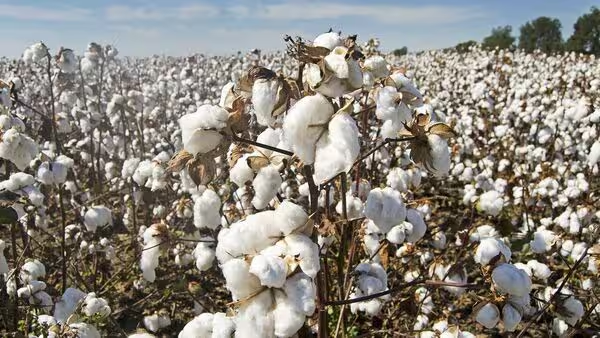- Courses
- GS Full Course 1 Year
- GS Full Course 2 Year
- GS Full Course 3 Year
- GS Full Course Till Selection
- CSAT
- 5 LAYERED ARJUNA Mentorship
- Public Administration Optional
- Online Program
- GS Recorded Course
- NCERT Batch
- Polity Module Course
- Geography Module Course
- Economy Module Course
- AMAC Module Course
- Modern India, Post Independence & World History Module Course
- Environment Module Course
- Governance Module Course
- Science & Tech. Module Course
- International Relations and Internal Security Module Course
- Disaster Management Module Course
- Ethics Module Course
- Essay Module Course
- Current Affairs Module Course
- ABOUT US
- OUR TOPPERS
- TEST SERIES
- FREE STUDY MATERIAL
- VIDEOS
- CONTACT US
India’s Cotton Story: From Growth to Struggle
India’s Cotton Story: From Growth to Struggle

- Cotton is a major cash crop in India, grown on 12 million hectares.
- India is the second-largest cotton producer globally, after China.
- Bt cotton is the only GM crop approved for commercial use in India.
- It was introduced in 2002 by Monsanto (Bollgard), in partnership with Mahyco.
The Cotton Boom (2002–2014)
- Between 2002-03 and 2013-14, cotton production rose from 13.6 to 39.8 million bales.
- Exports increased from less than 0.1 to 11.6 million bales; imports dropped from 2.2 to 1.1 million.
- India became the world's top cotton producer by 2015-16 and a major exporter.
- Yield rose due to hybrid varieties and Bt technology—from 127 to 566 kg/hectare.
- Bt cotton adoption reached 95% of total cotton area by 2013-14.
Technology Behind the Growth
- Indian scientists developed key cotton hybrids: H-4 (1970), Varalaxmi (1972), and LSS (1933).
- Bt cotton (2002) used genes from soil bacteria to kill bollworm pests.
- Bollgard-II (2006) had two Bt genes, targeting both bollworms and leafworms.
Post-2014 Decline: Yields & Output Fall
- After 2013-14, production stagnated and began to fall.
- Average output during the last 5 years has been ~33.8 million bales.
- In 2024–25, production is expected to drop to 29.5 million bales — lowest since 2008-09.
- Yield has declined to below 450 kg/hectare.
Unkept Promises of Bt Cotton
- Bt cotton was expected to reduce pesticide use and increase farmer income.
- While initial results were positive, pests like the pink bollworm developed resistance.
- Farmers returned to heavy pesticide use, increasing costs and ecological harm.
- Secondary pests like whitefly and mealybugs began damaging crops.
Research Findings on Bt Cotton
- Bt cotton failed to deliver long-term benefits in rainfed, smallholder conditions.
- High seed cost and low-density planting limited yield potential.
- Pink bollworm resistance led to more pesticide use and pest outbreaks.
- Farming became more capital-intensive with no sustained yield gain.
- Farmers now spend more on seeds, fertilizers, and pesticides than before.
- M.S. Swaminathan and others called Bt cotton unsustainable and unethical for poor farmers.
- Farmers were pushed back to traditional pest control methods like IPM.
- Suicide rates were higher in areas with high Bt adoption and low yields.
- High-density, short-season cotton is seen as a better option by experts.
Policy Paralysis and GM Regulation Failures
- In 2010, Bt brinjal was blocked despite scientific approval.
- Activist-led consultations were prioritized over expert advice.
- Under NDA, GM field trials were halted entirely.
- GM crops were treated as hazardous under the Environment Act, 1986.
- Innovations like hybrid GM mustard and pest-resistant cotton were blocked.
- Courts delayed approvals despite years of trials and safety data.
- No new cotton technology has been approved since Bollgard-II in 2006.
Pest Outbreaks Worsen the Crisis
- Pink bollworm infestations began in 2014 in central and southern India.
- By 2018, the pest had spread to northern cotton zones.
- New GM pest-resistant seeds were ready but not cleared.
- Farmers had no updated tools to handle emerging pest threats.
Imports Rise, Global Players Benefit
- Cotton imports doubled from $518.4 million to $1,040.4 million (Apr–Jan 2024-25).
- Exports declined from $729.4 million to $660.5 million in the same period.
- India has once again become a net importer of cotton.
- Countries like the US and Brazil benefit from India's production decline.
- US is likely to push India to remove the 11% import duty on cotton.
- India allowed GM soya meal imports in 2021; pressure for GM corn imports is rising.
Farmers Left Behind
- Farmers have no access to improved GM technologies developed in India.
- At the same time, imported GM food products are entering through ports.
- Farmers were never consulted then — and still aren't today.
GM Crops vs Traditional Pest Management (IPM)
|
Aspect |
GM Crops (Bt cotton) |
Traditional Pest Management (IPM) |
|
Core Idea |
Genetic resistance to pests |
Use of natural enemies and farm practices |
|
Initial Benefit |
Reduced pesticide use early on |
Encourages natural pest control, less chemical use |
|
Long-Term Performance |
Resistance builds up, yields stagnate |
Sustainable, adaptable over time |
|
Cost of Seeds |
High; hybrid seeds can’t be reused |
Low; farmers can save and reuse seeds |
|
Input Dependency |
High on costly seeds and fertilizers |
Low; relies on local inputs |
|
Pest Resistance |
Pink bollworm and others developed resistance |
Slower resistance due to diverse methods |
|
Secondary Pests |
Whitefly and mealybugs increased |
Better pest balance maintained |
|
Suitability |
Better for irrigated, large farms |
Better for rainfed, smallholder farms |
|
Environmental Impact |
High pesticide use, ecological imbalance |
Supports biodiversity, reduces pollution |
|
Farmer Training Needed |
Low initially, high later |
Needs moderate training and awareness |
|
Economic Risk for Farmers |
High risk of debt if crop fails |
Lower input cost, less financial risk |
|
Policy Support |
Backed by private sector, slow public approvals |
Needs stronger institutional support |
|
Also Read |
|
| Public Administration Optional | |
| UPSC Monthly Magazine | Question Answer Practice For UPSC |



